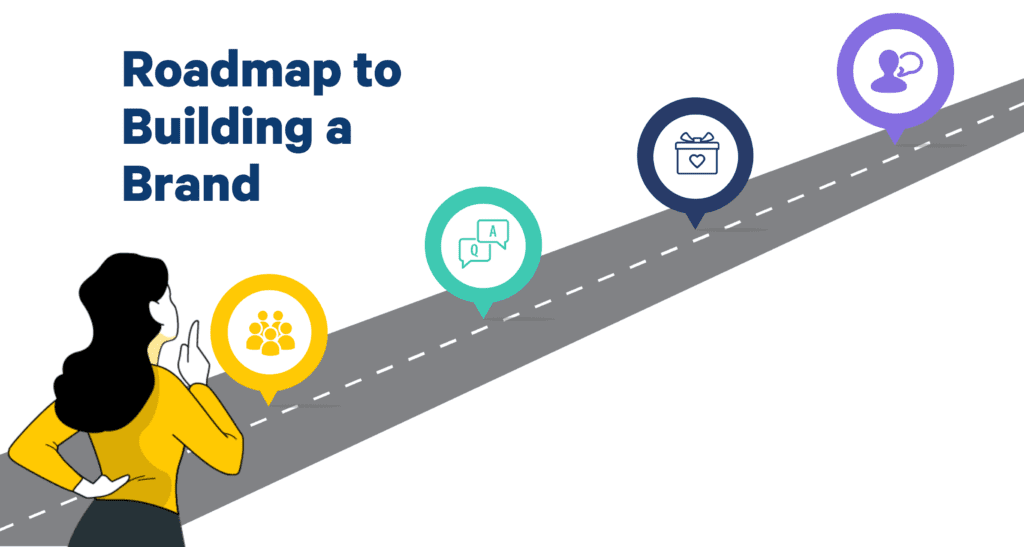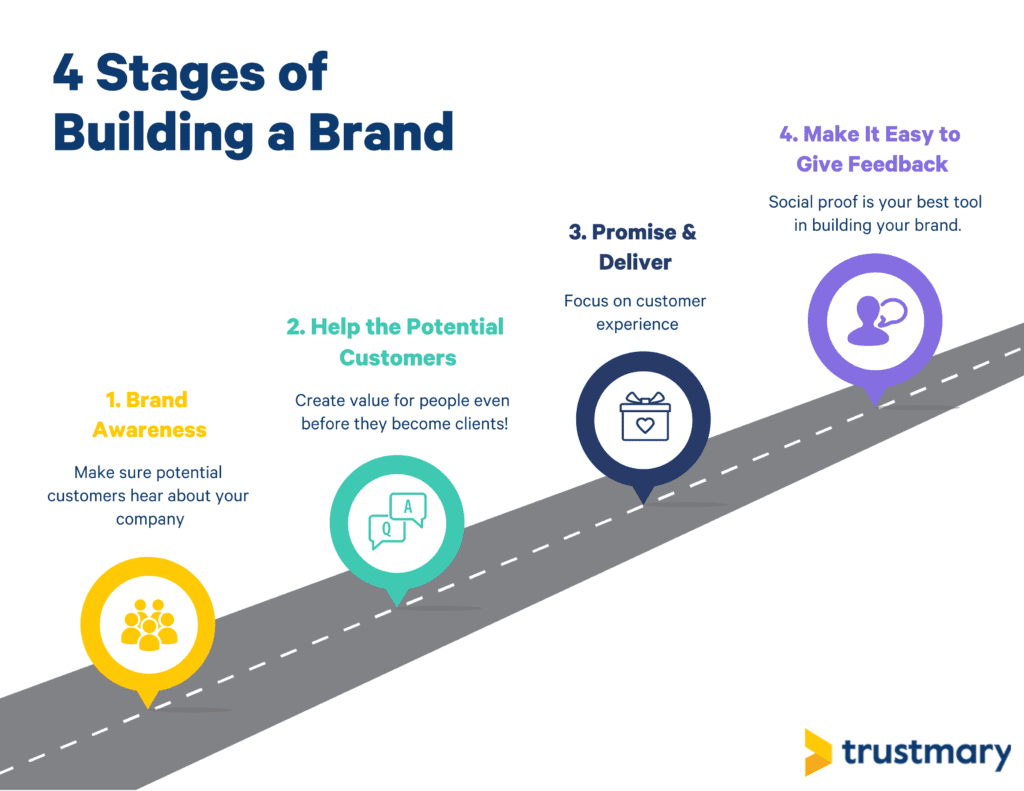Building a Brand and the Stages of Brand Building

Building a Brand and the Stages of Brand Building
There are many words in marketing that include "brand":
- Brands
- personal branding
- branding
- brand guidelines
- brand capital
- brand voice
- brand story
- brand value
- brand promise
- brand image
- brand identity
- brand strategy
- brand agency
- brand creation
- brand recognition
- brand mission statement
- brand this and brand that!
Brands and branding is a very popular topic amongst marketers.
"What do you think about this big online store advertising with this hideous commercial? Even if it brings profits it will for sure damage the brand capital. These people don't understand anything about marketing!"
Thinking about logos, polishing off the visual images and thinking on how we should communicate, to build our wanted brand image. Some say it what does it matter what it looks like, as long as it's bringing in the wanted results, and others are too busy worrying about the lost brand capital.
Even After Following All the Brand Guidelines...
The consumers buying from brands are completely unaware of the conversation being held behind closed doors. They wouldn't probably even notice, if the company changed their logo or the whole colorworld in one night. These changes wouldn't affect their target audience's shopping behavior much - if at all.
However, let us now forget what happened to GAP when they changed their brand logo and what made them change it back. Long story short: They spent loads of time and money on redoing their brand logo – only to have to change it back after their sales dropped big time right after launching the new logo.
For some reason, when speaking about creating a successful brand, the conversation often shifts off to the appearance, and how the marketing and/or products appear on the outside.
Then again, when you are planning to buy a pair of shoes, you are not focused on what the commercial looked like or made you feel, but instead what kind of past experiences you have with the brand. In other words, whether you have felt disappointment or had success with their products.
"I used to like Nike's shoes, but this last pair fell apart in a few months."
In a brand conversation, the red line of what is a brand is often lost. Could it be because people these days have so many different opinions on what a brand means?
What is a Brand?
Personally, the best definition of a brand that I have heard of came from Seth Godin:
”A brand is the set of expectations, memories, stories and relationships that, taken together, account for a consumer’s decision to choose one product or service over another. If the consumer doesn’t pay a premium, make a selection or spread the word, then no brand value exists for that consumer.”
Brand is a subjective advantage in the competition, that doesn't necessarily base on facts about the service provided.
It is based on facts about what kind of customer experiences the company has offered to its customers during the years, and what kind of thoughts or feelings the company raises.
In a way, you could speak about an intersubjective advantage, although some of the values of brands vary a lot between different persons.
You don't just build a brand with the visual images, logos and pretty commercials. Although these things affect the building of the brand. How much, that is another question. In some industries more than on the others.
Where Does the Brand Value Come from?
Brand value can be split into four parts:
- Notions, stories, expectations and memories, that are associated with the brand
- An awareness of those notions, stories, memories and expectations
- Effect of those things in your business
- The value of that effect
When you are complaining about an appearance, or a visual thing affecting the image of the brand, you are assuming that the brand image is the central part of the brand. In some brands this is of course the truth, but in many cases it's not that big of a deal.
Let's take for an example an online retail store. It is very difficult for me to imagine that the visual appearances would be the main focus of that type of a brand.
Sure, the visual image is still a requirement for getting the deal - nobody wants to do business at a junk yard. But the real effect that visual appearance has on the brand, can not be that huge. Of course, when it comes to the subjective competitive advantage, which is largely made up of feelings evoked by images and stories, it is difficult to say what the real impact of the various factors is.
In the end, the situation is that you can say one commercial is at the same time destroying, and developing the brand. There is no perfect meter for this. And while we lack the perfect meter, companies are using methods such as brand awareness or emotional associations.
From emotions, certain ones are seen as positive and some as negative ones, of the brand value. However, the impact on the purchasing decision itself is often hypothetical, with the exception of the fact that it is quite difficult to buy something that one does not know exists. Some might say, that these are the best meters we have at the moment, and it is best to focus on creating the positive emotions.
While the buyers are sharing stories on how the product has worked for them or how did their friends feel about using it, they are already creating expectations towards new products.
To me, that type of conversations sound like trying to explore the effects of Carl Jung's literature on readers by studying the book's font, font color and page thickness. Because, well, "These are the best indicators we have at the moment."
Focus on the Essential - 4 Stages of Building a Brand
Ok, so let's get down to business then shall we. The 4 stages of building a brand, in other words, how can you successfully build a brand without knowing how much the different factors are going to affect it.

1. Brand Awareness
The first stage in building a brand is to make sure that potential clients hear about your company. And now would be a good time to remind you, that this has very little to do with the actual brand advertising.
For the conspicuousness of the brand it doesn't really matter if a person hears about you for the first time through a cold-call, in the taxi queue at four am on the weekend, or from a tv-commercial.
Of course the way that a person hears about you will affect the customer experience they have from your company, and this way, also your company brand. But let's not forget, that the brand conspicuousness itself is worth nothing, and biggest part of the brand's marketing campaigns are not even building it. People prefer to focus more on something other than the actual commercials, so the wanted positive emotions are never being achieved.
Brand awareness is important, but it's also closely tied with lead generation.
2. Creating Expectations and Offering More Value - aka Helping the Potential Client
When somebody has already heard of you, they have a chance to buy something from you. Sometimes the first impression means so much to the customer that they are ready to buy your service immediately. And sometimes they will need recommendations, but if you are still building your brand image, there is none available yet.
In these cases, the only option is to help the customer, even through the years. The relevant thing isn't trying to sell, but to help. Helping the customer with the issues they are facing. Helping them with marketing (marketing offices), making them feel more beautiful (clothes), offering them a pleasure (soft drinks, Coca Cola), making them feel more masculine (car dealers).
3. Doing the Promised – and a Little More
When you are creating expectations for a client, and eventually getting them to make the purchase, it is time to deliver on those promises made. Time to do what has been promised, and preferably in a way that the customer is happily surprised, and will tell all her friends about the positive experiences they had with your company.
It is important to remember that each brand is built around a product or a service. Sure with time once the brand is strong enough, it can be used to help you expand on to new product segments, but usually only within a certain industry. Or at least for me, it is difficult to picture Apple's brand helping anyone being successful in the oil industry.
4. Make giving Recommendations Easy, Ask for Recommendations, Encourage People to Recommend You, and Spread the Recommendations of Your Company
So the brand is the images, stories, expectations and memories that (potential) customers combine with the brand.
So what better way to develop a brand than sharing people's positive stories and memories, and thus creating positive expectations for new potential customers. Essentially, you're building trust by showcasing social proof in the form of testimonials and reviews from existing customers.
Often in the whole brand discussion, we forget that we are people. We want to hear stories from other people. We want to buy from other people. We want to deal with people.
We don't trust the marketing speeches of a company as much as we trust our neighbor's personal experiences. Many times we even think that people will share the positive experiences they've had. In reality, it's far more common for people to share only the negative.
Sure it's also true, that brands such as Coca-Cola don't need to encourage people to recommend their products to their friends. Because there, a certain critical point in branding has already been crossed. But once discussing about building the brand for a smaller business, the main focus is on other people. (By the way, if you need a tool to gather recommendations with, check out Trustmary Solo.)
Conclusions about Building the Brand
The brand is built on stories, images, memories and expectations that people have about your business, service, or product. You can build a brand by reaching out to new people, helping them, creating expectations for them, meeting those expectations, and encouraging them to recommend.
A good brand sells itself, but a good brand does not build itself.
Building a good brand requires a lot of work, and it is not really worth trying to build a brand for every business. Many products that do not have any brand are sold with a strong personal branding. Because we are people. And as people we want to buy from people.
So, last but not least, the brand can be built in other ways. You can awaken stories and images many other ways as well as through the service itself. One of the best examples of this is Red Bull, who has perhaps created the most valuable brand in its field, with its sports marketing and its positive association. It should be noted, however, that I think speaking of Red Bull is not a very practical way of advising on how to start your brand building. Very few companies sell energy drinks in the global market with similar resources.
